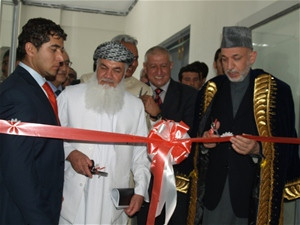
President Hamid Karzai and Minister of Energy and Water Ismail Khan inaugurating the power line from Uzbekistan to Kabul.
Advanced Engineering Associates Intl.
Multi-donor effort brings 24-hour, year-round power to Kabul, Mazari Sharif, and Puli Khumri.
24 OCTOBER 2009 | KABUL, AFGHANISTAN
Economic development in Afghanistan depends on a steady supply of electricity to power businesses and factories, and citizens enjoy a better quality of life when electricity heats and lights their homes and schools. Afghanistan’s power grid is currently under construction following years of war and neglect. USAID and a coalition of international donors have been working with the Government of the Islamic Republic of Afghanistan to provide more power to Afghan citizens. Today, thanks to these joint efforts, residents of Kabul, Mazari Sharif, and Puli Khumri – major cities in northern and central Afghanistan – now receive 24-hour, year-round electricity.
Until recently, the lack of a reliable power source meant that Afghanistan’s urban residents received power for only a few hours per day, if at all and providing reliable electricity to its citizens is a key strategic goal of the Afghan Government. To this end, the United States worked with the Afghan Government to negotiate a power purchase agreement to import electricity from Uzbekistan. Bringing that electricity to Afghanistan was achieved through the cooperative efforts of the U.S. Government, the governments of India and Germany, the Asian Development Bank, and the World Bank. From de-mining the transmission route to ensuring that the line was properly energized, USAID and other donors helped Afghanistan’s Ministry of Energy and Water and the country’s electric utility provide affordable and reliable electricity.
On May 7, 2009, Kabul began receiving 40 megawatts (MW) of power purchased from Uzbekistan. The electricity flowed for 400 km over the rugged Hindu Kush mountain range via a 220 kV transmission line. This electricity now lights more than 32,000 homes in Kabul alone and provides urgently needed power to create jobs and improve living standards. Eventually, the line will provide up to 300 MW of electricity – enough to power the homes of 1.5 million Afghans.
Residents of smaller cities like Aybak in Samangan Province also benefit. USAID built a transmission line to Aybak, bringing imported electricity to the homes of the city’s 150,000 inhabitants – homes that once received power only one to two hours per day. After Aybak received electricity, Samangan Governor Mohammed Acbarekshe said, “The idea of giving everybody access to power in my province is very exciting and hopeful and could not have come about without the help of USAID…we are very grateful.”







Comment
Make a general inquiry or suggest an improvement.